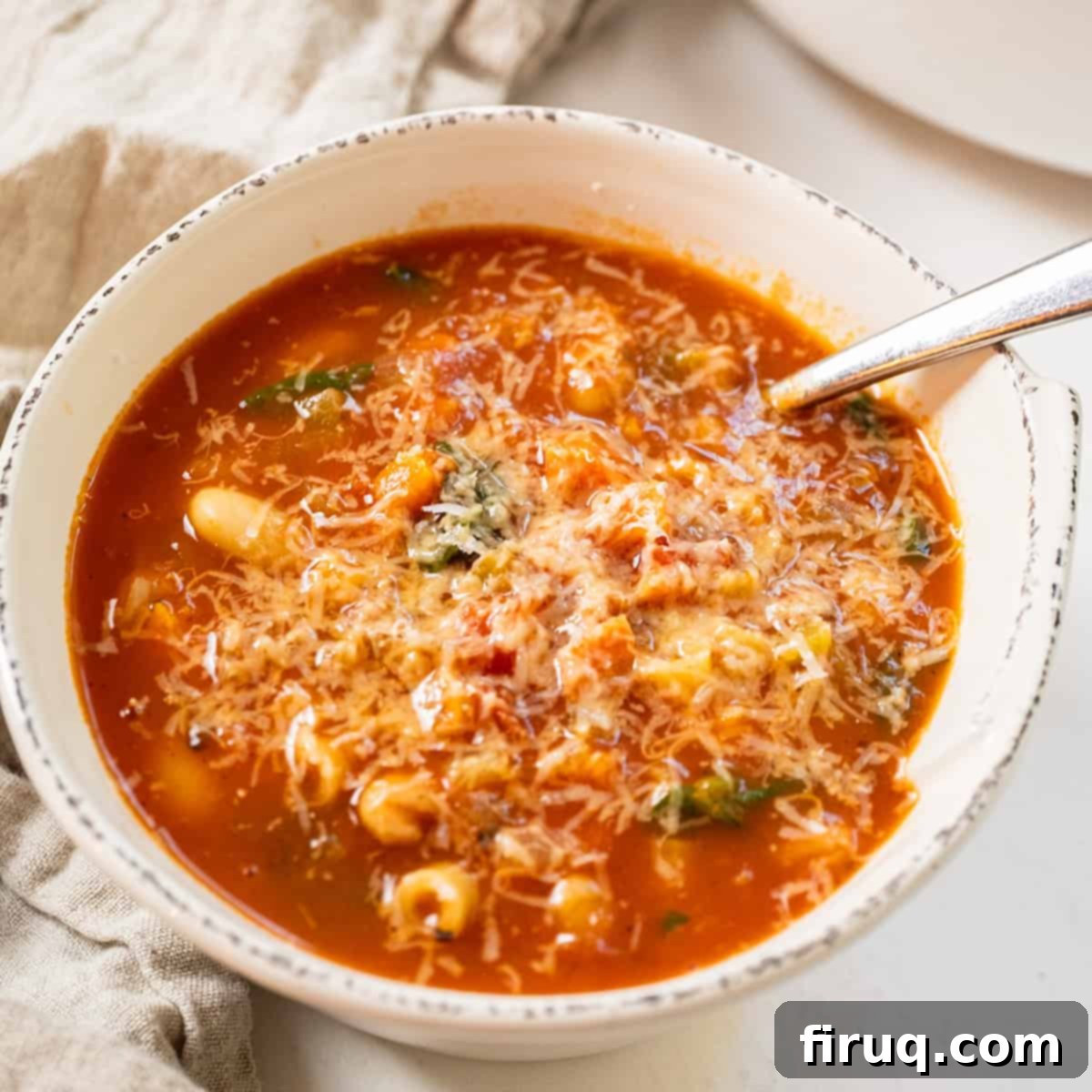Hearty Classic Pasta Fagioli: An Authentic Italian Soup Recipe for Your Family
Step into the warm, inviting world of traditional Italian cooking with our recipe for Classic Pasta Fagioli, affectionately known as “pasta fazool.” This isn’t just any soup; it’s a culinary embrace, a hearty, tomato-based masterpiece featuring crispy pancetta and tender ditalini pasta, perfectly balanced with wholesome cannellini beans. It’s the kind of comforting, deeply flavorful dish you’d find simmering in the kitchen of an old-school Italian nonna, and now, it can be the centerpiece of your own family dinner table. Easy to prepare and universally loved, Pasta Fagioli is more than just a meal; it’s an experience that brings warmth and joy to every spoonful.
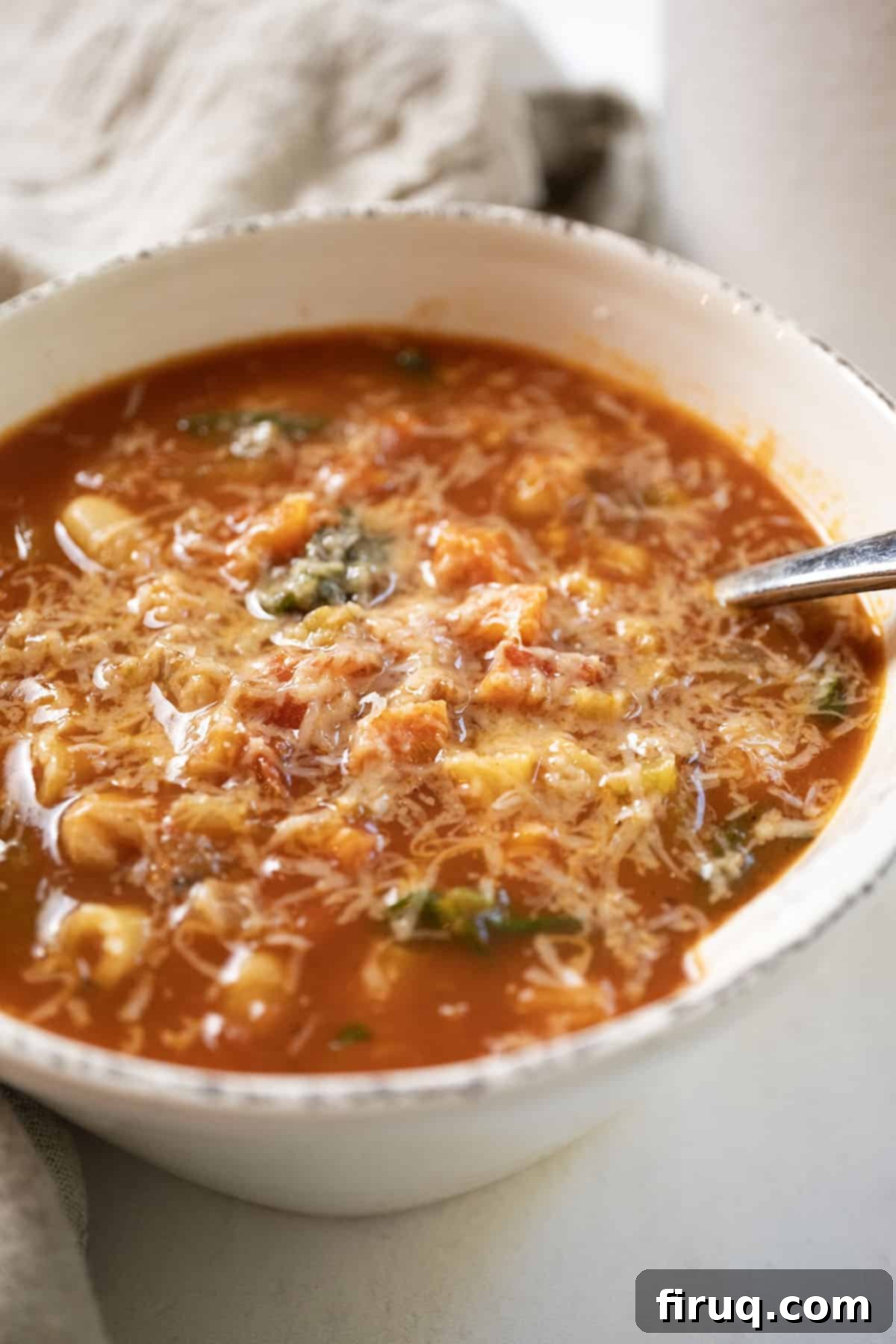
Craving more classic Italian soup recipes? Don’t miss our equally delightful Italian Wedding Soup or the rich and creamy Zuppa Toscana.
[feast_advanced_jump_to]
Pronouncing Pasta Fagioli: “Faa-jow-lee” or “Fazool”?
One of the charming quirks of Italian-American cuisine is the delightful blend of authentic Italian terms with localized pronunciations. When it comes to Pasta Fagioli, this is especially true. Do you say it the traditional Italian way, “faa-jow-lee,” emphasizing each syllable with an authentic Italian flair? Or do you, like many Italian-American families (including mine!), lean towards the more colloquial and endearing “Pasta Fazool“?
The truth is, both are perfectly acceptable! “Pasta Fazool” is a phonetic Anglicization of “pasta e fagioli” that has become a beloved part of culinary language, especially in regions with a strong Italian immigrant history. Regardless of how you choose to pronounce it, the essence of the dish remains the same: a deeply satisfying, flavorful, and incredibly comforting soup. In this recipe, we’ll guide you through creating a Pasta Fagioli with spinach that is both healthy and utterly delicious, a dish you’ll always want to have on hand, no matter how you say its name.
At its heart, “Pasta e Fagioli” simply translates to “pasta and beans.” Our version prominently features tender ditalini pasta paired with creamy cannellini beans. This foundational duo, combined with the savory richness of fried pancetta and a slow-sautéed sofrito, builds a symphony of flavors that gives this soup incredible depth and character. It’s a testament to the power of simple, quality ingredients coming together to create something truly extraordinary.
While perhaps not as ancient as some Italian culinary pillars like Classic Italian Minestrone or the iconic Spaghetti Carbonara, Pasta Fagioli has certainly earned its place as a cherished “oldie but goodie.” It’s a classic for a reason – its timeless appeal, ease of preparation, and incredible flavor profile make it one of my personal favorite soups to make at home. Plus, it’s a hit with the whole family, even my son loves it, which is always a win in my book!
Ingredients Notes and Expert Substitutions for Perfect Pasta Fagioli
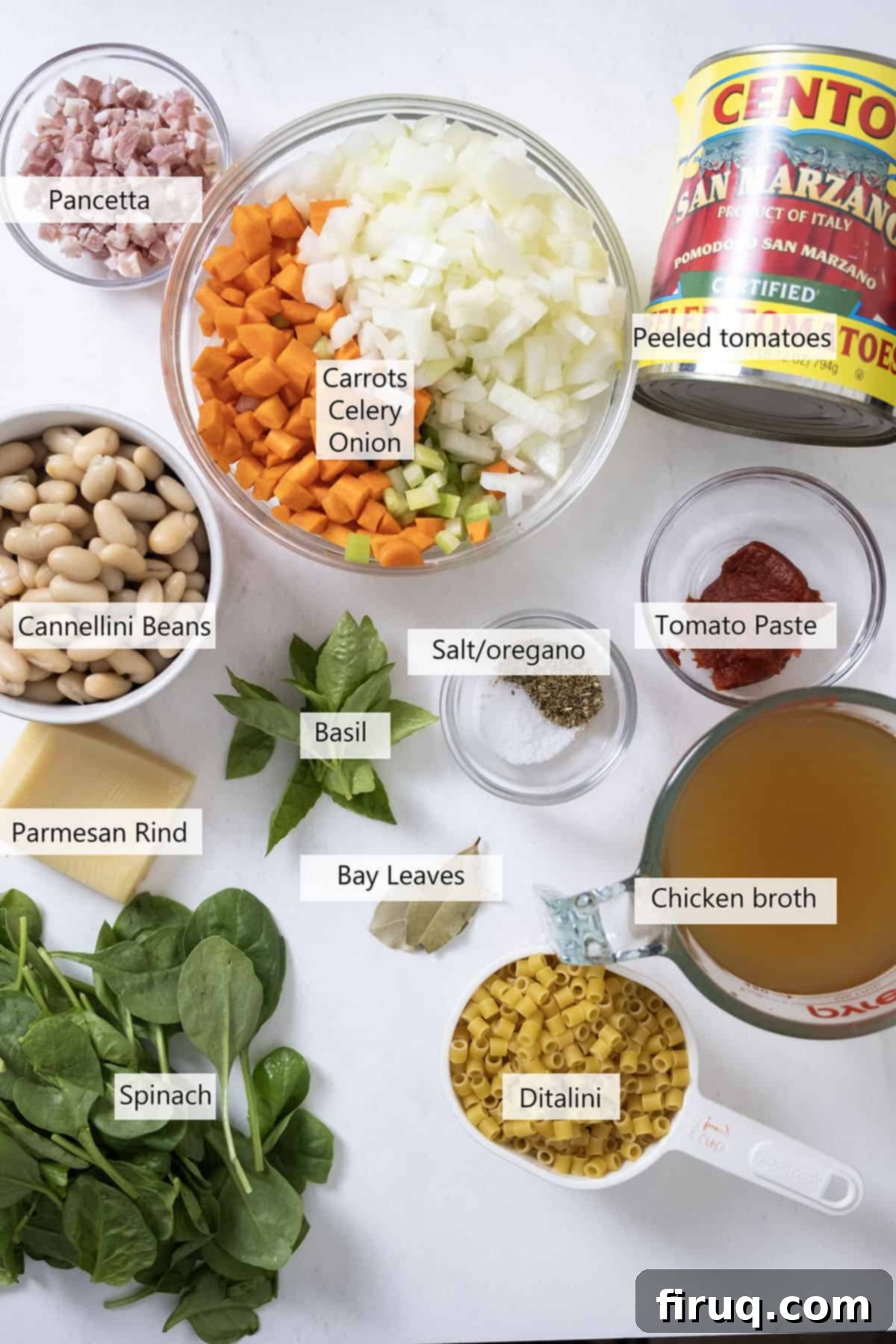
Crafting the perfect Pasta Fagioli begins with understanding the role each ingredient plays. Here’s a detailed look at the key components and how you can adapt them to your taste:
- Ditalini Pasta: This small, tubular pasta is traditional for Pasta Fagioli due to its perfect bite-sized shape and ability to absorb the soup’s flavors. You have a choice: cook it directly in the soup to infuse every strand with rich broth, or cook it separately. Cooking it separately prevents the pasta from soaking up too much liquid if you anticipate leftovers, keeping your soup from becoming overly thick. The choice is yours, based on your preference for texture and storage.
- Cannellini Beans: These white kidney beans are my top choice for their tender, creamy texture that holds up well in the soup without becoming overly mushy. While some recipes call for northern beans, I find them to be softer and more prone to breaking apart, which can alter the soup’s consistency. Kidney beans can also be added for a different color and slightly firmer texture, offering a pleasant variation.
- Parmesan Rind: This might seem like a small detail, but a parmesan rind is a secret weapon for adding an incredible depth of salty, nutty, and umami flavor to your soup. As it simmers, it slowly releases its delicious essence into the broth. Just remember to remove it before serving – you want the flavor, not a chewy surprise!
- Fresh Spinach: Incorporating leafy greens like spinach is a fantastic way to boost the nutritional value and add a vibrant touch to your meal. Spinach wilts beautifully into the hot soup, adding a subtle earthiness. If you’re looking for alternatives, Tuscan kale (lacinato kale) offers a slightly chewier texture and a more robust flavor, while escarole provides a pleasant bitterness that complements the rich broth. If you enjoy greens in your soup, be sure to try our flavorful Escarole and Beans Soup!
- Pancetta: In my humble opinion, pancetta is non-negotiable for an authentic Pasta Fagioli. This Italian cured pork belly is rendered until crispy, releasing a smoky, savory fat that forms the flavorful foundation of the entire soup. It adds an unparalleled depth that truly elevates the dish, making it exceptionally delicious.
- Crushed Tomatoes: The backbone of our rich tomato base. I prefer using high-quality whole plum tomatoes and hand-crushing them for a more rustic, chunky texture that I love in this soup. Alternatively, a good quality can of pre-crushed tomatoes works perfectly for convenience. The sweetness and acidity of the tomatoes are essential for balancing the hearty flavors.
- Sofrito (Carrots, Celery, and Onions): The aromatic trio that forms the flavor base of many Italian soups. Diced finely, these vegetables are sautéed slowly to release their natural sweetness and create a complex layer of flavor that melds beautifully with the pancetta.
- Garlic: Although not explicitly listed in the original snippet, garlic is a quintessential aromatic in Italian cuisine and should be added to the sofrito for its pungent, savory notes that enhance the overall profile of the soup.
- Olive Oil: Used for sautéing the sofrito and complementing the pancetta fat, ensuring all the vegetables cook evenly and develop their flavors.
- Tomato Paste: A concentrated burst of tomato flavor that, when caramelized, adds an incredible depth and richness, making the soup more robust and savory.
- Chicken Broth (or Vegetable Broth): The liquid base of the soup, providing body and carrying all the delicious flavors. For a vegetarian version, swap chicken broth for a high-quality vegetable broth.
- Seasonings (Salt, Pepper, Oregano, Basil, Bay Leaves): These herbs and spices are crucial for rounding out the flavors. Oregano and basil provide classic Italian aroma, while bay leaves contribute a subtle, earthy undertone that deepens as the soup simmers. Always taste and adjust salt and pepper to your preference.
*Please refer to the detailed recipe card below for precise measurements and quantities of each ingredient.
How to Craft the Perfect Pasta Fagioli: Step-by-Step Guide
Creating this comforting bowl of Pasta Fagioli is a delightful process, building layers of flavor with each step. Follow these instructions closely for a truly authentic and delicious result:
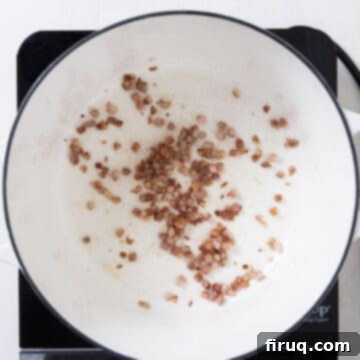
Step 1: Render the Pancetta. In a large Dutch oven or sturdy pot, add your chopped pancetta. Place it over medium heat and allow the fat to slowly render out, which is crucial for building deep flavor. Continue to sauté until the pancetta turns beautifully golden brown and becomes irresistibly crispy. This process usually takes around 8 minutes. Once crispy, remove the pancetta with a slotted spoon and set it aside, leaving the flavorful rendered fat in the pot. If using olive oil, add it now.
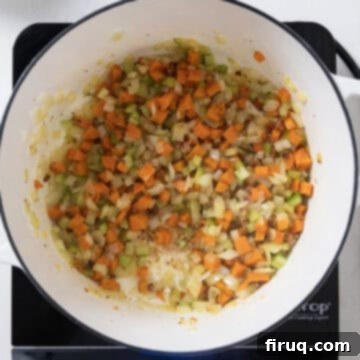
Step 2: Sauté the Sofrito. To the same pot with the rendered pancetta fat (and olive oil, if added), stir in the diced carrots, celery, and onions. Sauté these aromatics for about 10 minutes, stirring occasionally, until they become beautifully softened and translucent. This slow sauté coaxes out their natural sweetness, building the foundational flavor of your soup. Halfway through, season with half of the salt, pepper, and oregano to infuse the vegetables as they cook.
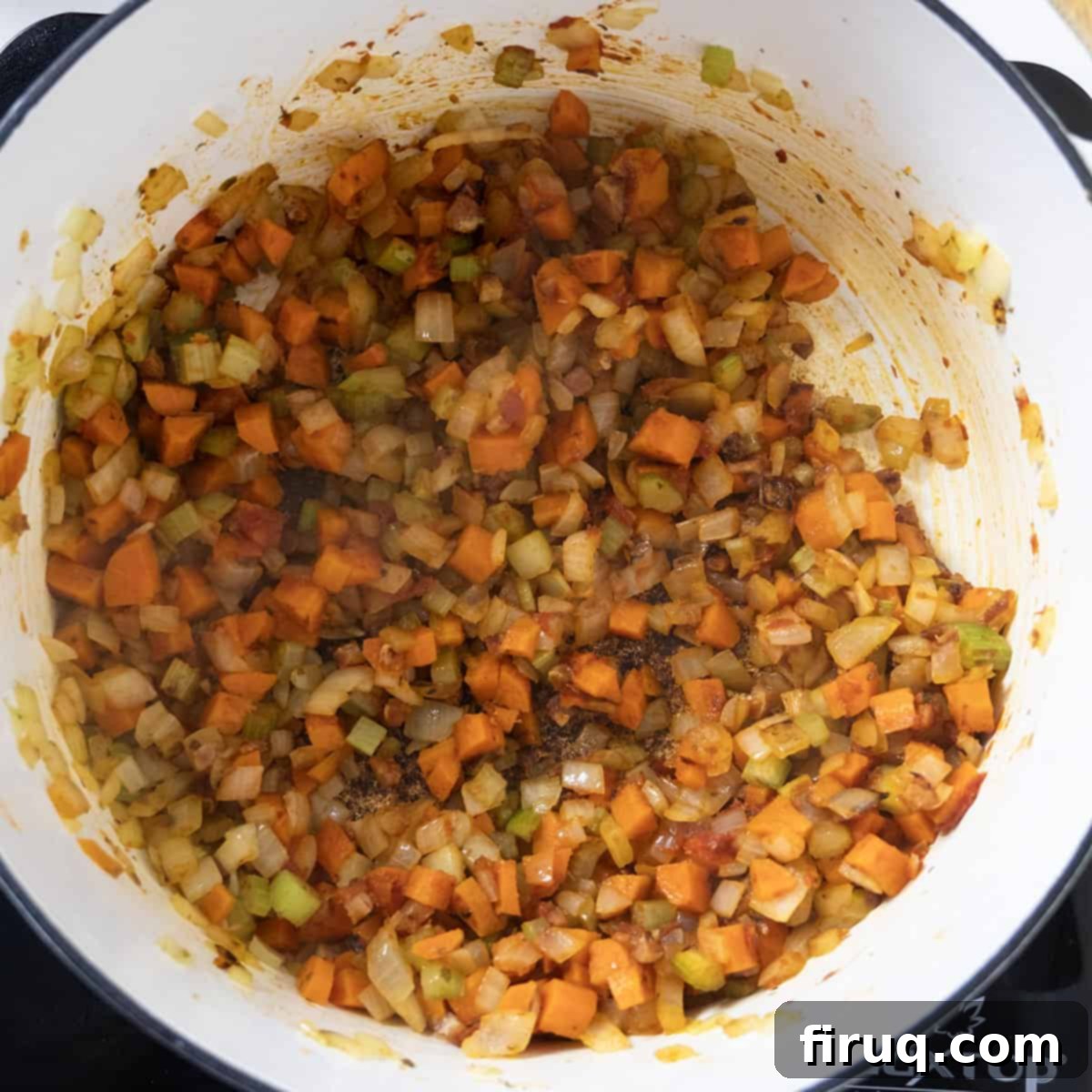
Step 3: Caramelize the Tomato Paste. Push the sautéed vegetables to the sides of the pot, creating a small well in the center. Add the tomato paste directly into this space. Allow it to caramelize undisturbed for about 3 minutes. This step deepens its flavor and color significantly. Then, stir the caramelized paste thoroughly into the vegetables and let everything cook together for a few more minutes, allowing the flavors to meld.
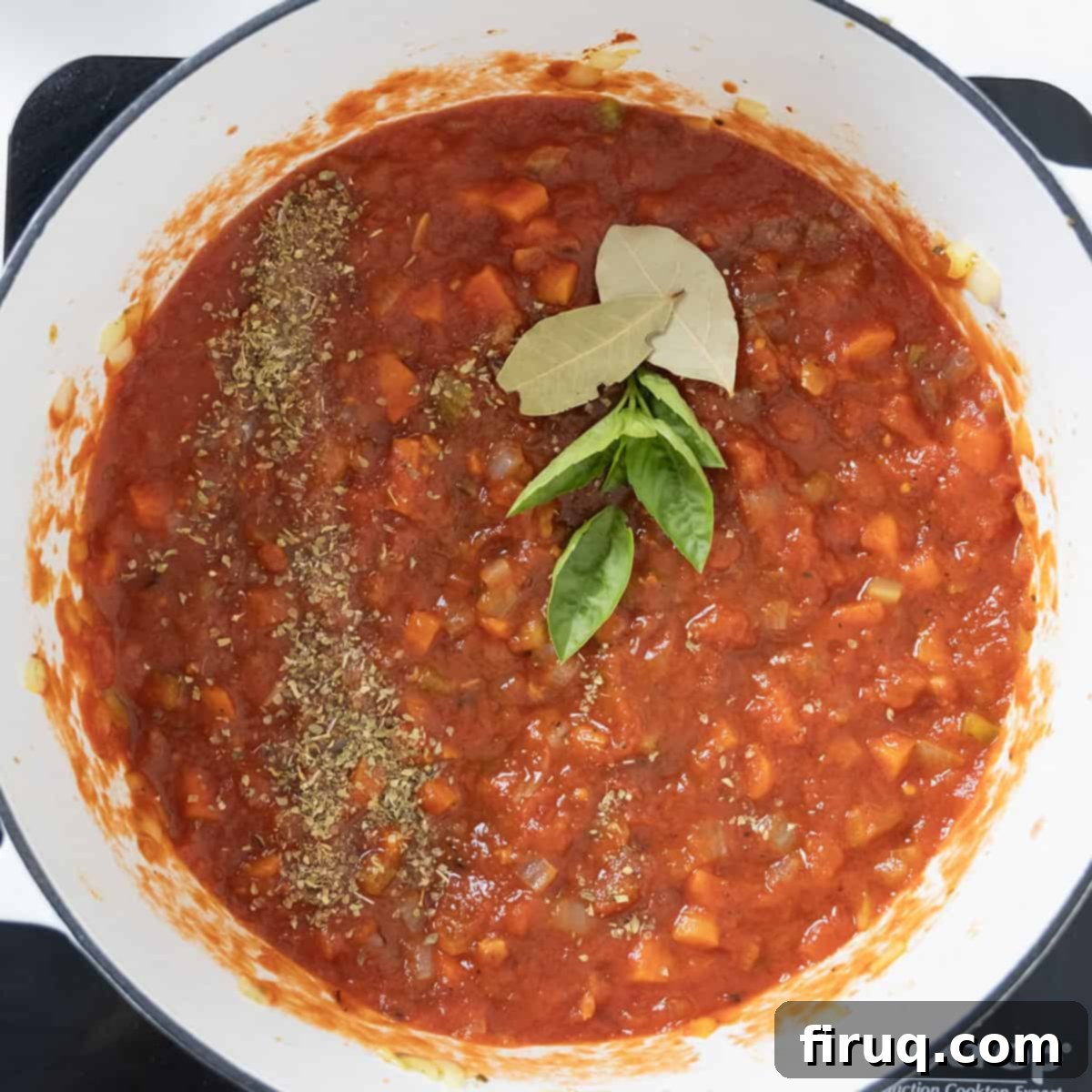
Step 4: Add Tomatoes and Seasonings. Pour the crushed tomatoes (either hand-crushed or from a can) into the pot with the sautéed vegetables. Add the fresh basil, the remaining salt, pepper, and oregano, and the bay leaves. Stir everything to combine well. Increase the heat slightly and bring the mixture to a gentle simmer, allowing the tomato flavors to awaken.
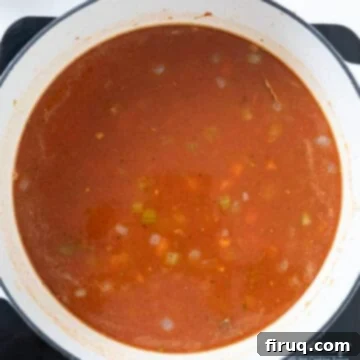
Step 5: Simmer the Broth with Parmesan Rind. Pour in the chicken stock (and water, if using) and gently add the parmesan rind. Give everything a good stir to ensure all ingredients are well combined. Bring the soup to a rolling boil, then reduce the heat to low and let it gently simmer for 15 minutes. This simmering time allows the flavors to meld and the parmesan rind to infuse the broth with its irresistible umami.
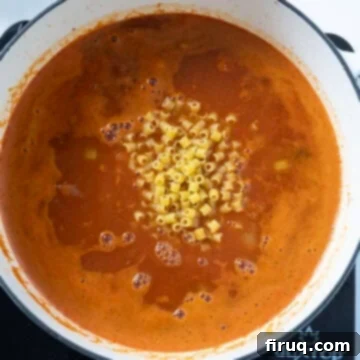
Step 6: Cook Pasta and Beans. Now, it’s time to add the hearty components. Introduce the cannellini beans (drained and rinsed) and the ditalini pasta to the simmering soup. Continue to simmer for another 15 minutes, or until the ditalini pasta has reached a perfect al dente tenderness. Make sure to stir the soup occasionally to prevent the pasta from sticking to the bottom of the pot, ensuring even cooking.
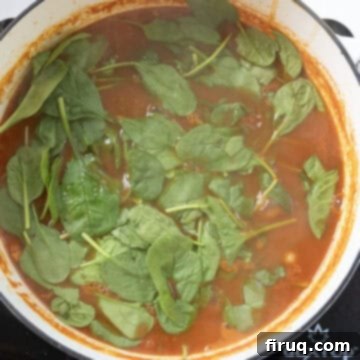
Step 7: Wilt the Spinach. Once the pasta is cooked, add the fresh spinach directly on top of the simmering soup. Cover the pot with a lid for about 3 minutes. The steam and residual heat will gently wilt the spinach. After 3 minutes, remove the cover and stir the softened spinach into the soup until it’s fully incorporated.
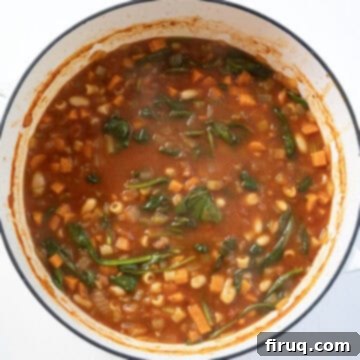
Step 8: Final Touches and Serve. Before serving, carefully remove and discard the bay leaves and the parmesan rind from the soup. Ladle the hot Pasta Fagioli into bowls, and garnish generously with freshly grated Parmesan cheese and the reserved crispy pancetta for an extra layer of flavor and texture. It’s perfect to serve as a comforting lunch on its own or alongside a fresh salad, like an Easy Chipotle BBQ Chicken Salad, a vibrant Grilled Shrimp Salad with Mango Lime Dressing, or a classic Caesar salad featuring our Traditional Caesar Dressing. For a hearty soup and sandwich pairing, the Chopped Italian Sandwich is an absolutely irresistible choice!
Pro-Tips for Your Best Pasta Fagioli Ever
Mastering Pasta Fagioli is all about understanding a few key techniques that enhance its traditional flavors. Here are some expert tips to ensure your soup is outstanding every time:
- Caramelize the Tomato Paste for Deeper Flavor: This step is a game-changer. By allowing the tomato paste to cook directly on the bottom of the Dutch oven for a few moments before stirring it into the vegetables, you encourage its sugars to caramelize. This process develops a richer, less acidic, and more intensely savory tomato flavor, adding incredible depth to your soup that simply mixing it in won’t achieve. This small effort yields a significant flavor payoff.
- To Cook Pasta Separately or Together: I typically prefer to cook my ditalini pasta directly in the soup. As the pasta simmers, it absorbs the flavorful broth, becoming an integral part of the dish and releasing a bit of its starch to slightly thicken the soup. However, if you plan on having leftovers, consider cooking the pasta separately and adding it to individual bowls just before serving. This prevents the pasta from continuously absorbing liquid in the fridge, which can lead to it becoming mushy and the soup becoming too thick overnight.
- Achieve the Perfect Tomato Texture: For that authentic, rustic Italian feel, I love a bit of chunkiness to the tomatoes in my Pasta Fagioli. Using whole plum tomatoes and hand-crushing them allows for varying textures that add character to the soup. If you prefer a completely smooth soup, you can achieve this by using an immersion blender to purée the crushed tomatoes directly in the pot before you add the broth, or by blending canned whole tomatoes before incorporating them into the sofrito.
- Don’t Skimp on the Pancetta: The rendered fat from the pancetta is liquid gold. It’s the base of your sofrito and adds a crucial layer of savory, smoky flavor. If you don’t have pancetta, quality bacon can be a substitute, but pancetta’s milder, sweeter cure is ideal.
- Adjust Broth Consistency: Pasta Fagioli can vary in thickness. If your soup is too thick for your liking after the pasta has cooked, simply add a bit more chicken or vegetable broth (or water) until you reach your desired consistency. Remember, the pasta will continue to absorb liquid even after it’s cooked.
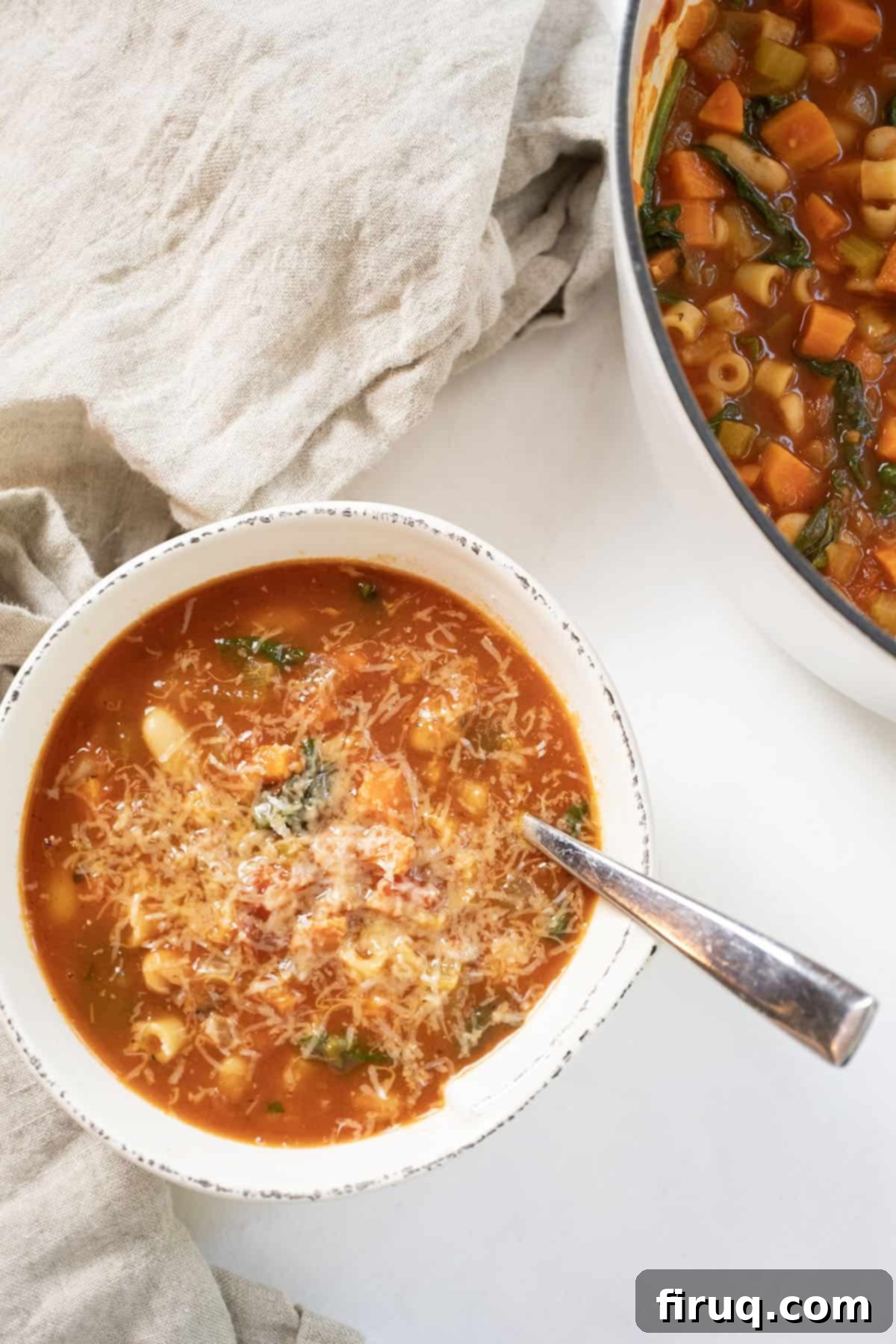
Common Questions About Pasta Fagioli
Have questions about making this classic Italian soup? Here are some frequently asked questions to help you perfect your Pasta Fagioli:
While both are classic Italian vegetable-based soups, the primary difference lies in their core ingredients and consistency. Pasta Fagioli, as its name suggests (“pasta and beans”), always features beans (typically cannellini) and pasta as central components, resulting in a heartier, often thicker, and chunkier soup. Minestrone, on the other hand, is a more versatile vegetable soup that can vary widely by region and season. While it can include pasta or rice, and sometimes beans, its emphasis is generally on a wider variety of vegetables, often resulting in a lighter broth and a less dense consistency.
In Italian, “fagioli” (pronounced faa-jow-lee) literally means “beans.” Therefore, “pasta e fagioli” translates directly to “pasta and beans.” This simple name perfectly encapsulates the humble yet delicious nature of this beloved peasant-style dish, highlighting its two primary ingredients.
Absolutely, Pasta Fagioli is an excellent candidate for freezing, making it perfect for meal prep! I often make a large batch with freezing in mind, keeping half in the fridge for immediate enjoyment and storing the rest in the freezer. To freeze, allow the soup to cool completely. Then, transfer it to freezer-safe Ziploc bags or airtight containers. I like to lay the bags flat on an ice pack for about 15 minutes before transferring them to the freezer to help them freeze more quickly and maintain texture. When ready to eat, thaw overnight in the fridge and reheat gently on the stovetop, adding a splash of broth or water if needed to adjust the consistency. Remember the tip about cooking pasta separately if you plan to freeze!
Yes, absolutely! To make this recipe vegetarian, simply omit the pancetta and use a high-quality vegetable broth instead of chicken broth. For extra depth of flavor, you can start by sautéing the sofrito in a good amount of olive oil, and consider adding a smoked paprika or a tiny dash of liquid smoke to replicate some of the savory notes that the pancetta provides.
When stored properly in an airtight container, your homemade Pasta Fagioli will keep well in the refrigerator for 3-4 days. As mentioned in our pro tips, if you cooked the pasta directly in the soup, it might thicken considerably as it sits, absorbing more liquid. You can easily thin it out when reheating by adding a bit more broth or water.
Perfect Pairings: What to Serve with Pasta Fagioli
The beauty of Pasta Fagioli is its versatility. It’s robust enough to stand on its own as a fulfilling meal, yet it also complements a variety of other dishes for lunch or dinner. Its rich, savory profile makes it incredibly adaptable to different culinary pairings.
For a light lunch, a small bowl of Pasta Fagioli is wonderfully warming and satisfying. If you’re looking to round out your meal, it pairs magnificently with a fresh, crisp salad. Imagine a vibrant Easy Chipotle BBQ Chicken Salad offering a delightful contrast of flavors, or a refreshing Grilled Shrimp Salad with Mango Lime Dressing for a touch of brightness. Of course, you can never go wrong with a classic Caesar salad, especially when dressed with our homemade Traditional Caesar Dressing. The creamy dressing and crisp lettuce provide a perfect textural and flavor counterpoint to the hearty soup.
If you’re in the mood for that quintessential “soup and sandwich” experience, look no further than our mouth-watering Chopped Italian Sandwich. The medley of Italian meats, cheeses, and tangy dressing in the sandwich creates an irresistible combination with the warm, comforting soup.
For a more substantial dinner, Pasta Fagioli can serve as a fantastic appetizer or side dish to a classic Italian main course. It goes wonderfully with elegant entrées like tender Crispy Italian Chicken Cutlets, or more traditional dishes such as our Restaurant-Style Chicken Francese or the rich and earthy Chicken Marsala. The soup’s robust flavors hold their own without overwhelming the main dish, making it a perfect accompaniment.
While this homemade recipe offers an authentic and elevated experience, Pasta Fagioli is also one of the famous “all-you-can-eat” soups at many popular Italian-American restaurants. Our version, with its fresh ingredients and layered flavors, is a delicious rendition that stands proudly against any restaurant offering, much like our popular Zuppa Toscana or our recipe for Better Than Olive Garden Eggplant Parmigiana.
More Comforting and Hearty Soup Recipes You’ll Love
If you’ve fallen in love with the comforting warmth of Pasta Fagioli, you’re in for a treat! Our kitchen is brimming with other delicious and hearty soup recipes perfect for cozy evenings or satisfying lunches. Explore these favorites:
- Creamy Mushroom Mascarpone Soup
- Rustic Italian Tortellini Soup with Sausage
- Barley Lentil Soup
- White Bean Lentil Soup
If you’ve enjoyed making and savoring this recipe, please consider leaving a review below! Your feedback is incredibly helpful and appreciated by our community. For more delicious cooking content and behind-the-scenes glimpses, be sure to follow us @vindelgiudice on Instagram!
📖 Recipe
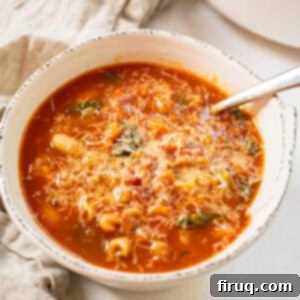
Classic Pasta Fagioli
Vincent DelGiudice
Pin Recipe
Equipment
-
1 Large Dutch Oven
Ingredients
- 2 carrots, diced
- 2 celery stalks, diced
- 1 medium onion, diced
- 4 oz pancetta, chopped
- 1 28 oz can whole plum tomatoes
- 1 handful basil
- 2 bay leaves
- 1 tablespoon oregano
- ¾ cups ditalini
- 4 cups chicken broth
- 1 cup water
- 1 can cannellini beans
- 1 parmesan rind
- 1 bag spinach, chopped
- 2 tablespoon olive oil
- 2 tablespoon tomato paste
- 2 cloves garlic, minced
Instructions
-
In a large Dutch oven or pot, add chopped pancetta and raise the heat to medium. Sauté until the fat renders and the pancetta becomes crispy. It will take about 8 minutes. Remove crispy pancetta and set aside. Stir in the olive oil, carrots, celery, onions, and minced garlic and sauté for about 10 minutes until they are softened. Add half of the salt, pepper, and oregano during this process.
-
Make a well in the vegetables where you can place the tomato paste. Let it caramelize in the pot for 3 minutes before stirring it into the vegetables. Then stir it throughout the vegetables and let the vegetables cook for a few more minutes, ensuring all flavors are well combined.
-
Pour crushed tomatoes (hand-crushed or canned) into the vegetables and add the basil, the rest of the seasonings, and the bay leaves. Stir well and bring it to a gentle simmer.
-
Pour in the chicken stock and water, and add the parmesan rind. Stir everything together to combine thoroughly and bring it to a boil. Then reduce the heat to low and return the soup to a gentle simmer for 15 minutes, allowing the flavors to deepen.
-
Add the drained cannellini beans and ditalini pasta to the pot. Continue to simmer for another 15 minutes, or until the pasta has softened to your desired al dente texture. Stir occasionally to ensure the pasta doesn’t stick to the bottom of the pan and cooks evenly.
-
Finally, add the fresh spinach on top of the soup. Cover the pot for 3 minutes to allow the spinach to gently wilt. Remove the cover and stir in the spinach until fully incorporated. Before serving, remove the bay leaves and parmesan rind. Ladle into bowls and garnish with the reserved crispy pancetta and fresh Parmesan cheese.
Notes
- To release the most flavor from the tomato paste, let it caramelize on the bottom of the Dutch oven for a few moments before adding the tomatoes and broth. This develops a richer, deeper tomato flavor.
- I prefer to cook my pasta in the soup because the pasta will absorb the flavor and contribute starch for a thicker broth. However, you can cook it separately if you think you’ll have leftovers. This way the pasta won’t absorb all the broth while in the fridge, preventing mushiness and overly thick soup. Add pre-cooked pasta to individual bowls just before serving.
- For a truly authentic taste, use good quality San Marzano style whole plum tomatoes and hand crush them for a rustic texture.
- For a vegetarian version, omit the pancetta and use vegetable broth instead of chicken broth. Start by sautéing the sofrito in a generous amount of olive oil.
- This soup freezes beautifully. Allow it to cool completely before transferring to freezer-safe containers or bags. Thaw overnight in the fridge and reheat gently, adding more broth or water if needed.
Nutrition
